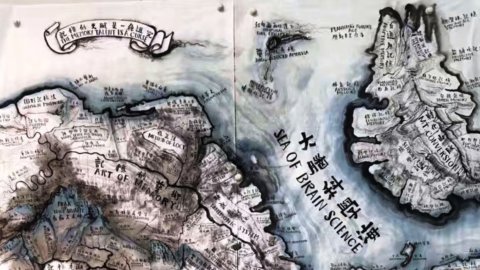The exhibition reflects on China's past which becomes artistic, cultural and spiritual memory. Starting from the Forbidden City in Beijing, 17 contemporary Chinese artists – Xu Bing, Gu Wenda, Qiu Zhijie, Feng Lianghong, Song Dong, Sui Jianguo, Li Songsong, Song Ling, Leng Bingchuan, Zhu Bingren, Geng Xue, Peng Wei, Jiang Jian , Li Hongbo, Zhang Qikai, Li Mingwei, Shang Yang – reinterpret one of the symbols of China and its millenary history. To trace an ideal link between Venice and China, as an element of mediation between the two cultures, five masters of Italian design – Antonio Citterio, Michele De Lucchi, Stefano Giovannoni, Piero Lissoni and Italo Rota – were entrusted with the task of creating in collaboration with Italian artisans, objects of common use in wood, with the possible addition of silk or ceramics, inspired by Chinese decorative and applied arts.
The exhibition itinerary takes into account the serious accident that took place on 4 April when, off the coast of Colombo (Sri Lanka), a fire on the MSC "Daniela" cargo ship, which was carrying the works of Chinese artists, prevented their arrival in the lagoon.
Starting from the awareness of what happened, the curators wanted to take on the character of an adventure to propose a new exhibition, designed on a dialectic that envisaged a 'prologue', a 'dialogue' and a synthesis, originally dedicated to the exhibition of works, in a provocative meditation on their absence.
The first half, conceived as a "prologue", consists of a total immersion, through images and installations, in the treasures that the Forbidden City has radiated for six hundred years now: from the beginning of the fifteenth century, when the immense imperial residence was erected in Beijing from the Ming dynasty, to an actuality in which it is handed down, contaminated and recreated in multiple linguistic, historical, visual, philosophical idioms.
In the second half, which assumes the modality of "dialogue", this legacy of Chinese culture becomes a resource, inherited by five masters of Italian design, placed in the conditions to experience creativity and ingenuity in contact not only with the themes and languages of that art, but also with the material in which it historically manifests itself: wood, silk, iron, ceramic. From these interactions come the chair by Antonio Citterio, the lamp by Michele De Lucchi, the armchair by Stefano Giovannoni, the sideboard by Piero Lissoni, the table by Italo Rota, works accompanied by black and white videos that tell the backstage of their creations .
The third time is announced by the seventeen short films shot in the ateliers of the 17 contemporary Chinese artists committed to making their own creations that reflect on China's past which becomes artistic, cultural and spiritual memory. The works interpret the memory of China and its millenary history.
These are images from which a widespread sense of imminence takes shape, upon which rests the inexorable coup de théâtre of that news from Sri Lanka: "Cargo in flames, works of the Biennale blocked".
“And so the journey continues – underlines Davide Rampello – following the path of a symbolic and increasingly clear awareness of what happened. Now recalling the sensitive traces through a story, now seeking orientation among the profound resonances of the words of an "etymological handbook of the event", now colliding with the gigantic vision of the burning cargo. Here is the representation of what never was. The unfinished work that takes place in the gaze of those who contemplate it. The abstract simulation of a reality that hasn't happened yet. Contemporaneity that becomes, therefore, Memory”.
The objective of the initiative, that of reflecting on the value and destiny of art in today's China, does not fail. In recent decades, contemporary Chinese art has seen the affirmation of an important generation of artists and the birth of new galleries and collectors; to these must be added the sudden creation of museums and formidable academies and universities that are favoring a large, informed and aware public.
As Gianfranco Maraniello states, “Memory and Contemporaneity is not only an opportunity to observe the works of some of the most interesting Chinese artists of the recent scene, but it is an attempt to consider deeper roots in a cultural tradition which, starting from the imaginary of the Forbidden City, opens up to non-approved values for contemporary art”.
This will be immediately guaranteed through the exhibition of a first group of works (which were not on the cargo ship) and, subsequently, will be completed with the installation of all the other planned works, once they arrive in Venice.
Image: Qui Zhijie, Memory is not Reliable, ink / ink painting, 2016





